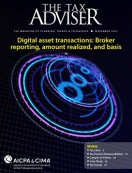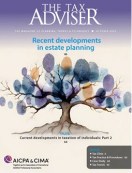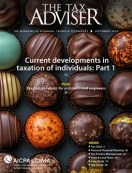- newsletter
- TAX INSIDER

Tax incentives for college students: Part 2
How scholarships affect tax and who gets the tax benefit for paying back student loans.
Please note: This item is from our archives and was published in 2020. It is provided for historical reference. The content may be out of date and links may no longer function.
Related
IRS clarifies health savings account changes in H.R. 1 in new notice
Government withdraws defense of retirement fiduciary rule
IRS outlines details for Trump accounts
College is very expensive, yet for many people it is essential for future success. This two-part article discusses the tax incentives to help parents and children pay for this important passage in life. Part 1 of this article examined the options to save for college and the tax credits and deductions available to B and his parents as he began college. But what if he receives scholarships? What is taxable? This part applies knowledge from Part 1 to explain the taxability of scholarships and who gets the deduction for repaying the student loans.
Taxability of scholarships
While there are tax incentives to assist in the cost of education, some students may also qualify for scholarships. The conundrum occurs when parents or students must determine what portion of the scholarship might be taxable. Sec. 117 excludes any amount of a qualified scholarship that is used for qualified expenses: tuition and fees required for enrollment or attendance at an eligible school, and required course-related expenses including fees, books supplies, and equipment, but not room and board.
If B is, for example, an all-star basketball player who is given a full scholarship, the amount of the scholarship designated as covering room and board is taxable. Many schools provide students with a Form W-2, Wage and Tax Statement, for this amount, but, even if the university does not provide a W-2, it is still the student’s obligation to claim the room and board portion as taxable income. The student would put the amount of room and board scholarship on line 1 of Form 1040, U.S. Individual Income Tax Return, with “SCH” beside it to designate it as scholarship income.
If B is a graduate student receiving a scholarship, the rules become a bit more complex. If the student works for the scholarship, it is taxable unless the hours worked are for a teaching or researching institution. Many schools have broad definitions of teaching and researching, such as assisting professors with proctoring exams, grading papers, or supporting an instructor’s research. If the student meets the definition of teaching and researching, the scholarship is not taxable.
However, what if the student is not teaching or researching? For example, B is a graduate student whose scholarship requires him to work for the career services division of the university organizing job fairs. Because this is neither teaching nor researching, it is not excluded from income under Sec. 127.
Even though it is taxable under Sec. 117, it might be excluded under Sec. 127. Under Sec. 127, a taxpayer can exclude up to $5,250 of employer-paid education assistance included in his or her Box 1 W-2 wages, if the assistance is provided as part of an educational assistance program as defined by Sec. 127(b). Since B is being paid by the university through a scholarship and uses the scholarship to pay the university for his education, in essence, the university (B‘s employer) is paying itself for his education. Therefore, while B‘s scholarship is taxable because he is not teaching and researching, $5,250 is excluded from his taxable income under the premise that his employer paid for his education.
What if B is every parent’s dream and earns so much in scholarship money that it exceeds his expenses? What is taxable then? Considering the scholarship exceeds expenses, then the excess is not being used to cover educational expenses, so Sec. 117 does not apply since that only excludes amounts used for qualified expenses. The amount above educational expenses is considered W-2 income and goes on line 7 of Form 1040 with SCH beside it.
Ordering rules
Despite the caveats that Sec. 529 plan distributions and scholarships are nontaxable if used for qualified expenses, the same expenses cannot be used to consider the distribution and scholarship as nontaxable. Essentially, the IRS does not want individuals “double dipping” and using the same $5,000 in tuition to make a $5,000 scholarship nontaxable and to exclude a $5,000 529 plan distribution from income. To prevent this, an individual must apply ordering rules to determine whether scholarships and distributions are nontaxable.
For example, assume B has $20,000 in expenses, received a $6,000 scholarship, and withdrew $11,000 from his 529 plan. He would like to use the American opportunity credit (AOC) on his return. The ordering rules first use nontaxable scholarships to reduce expenses, then the amounts taken for AOC or lifetime learning credit (LLC), and finally, the 529 distribution is applied to the remaining expenses.
In this scenario, B‘s nontaxable scholarship of $6,000 leaves $14,000 in expenses. He wants to use the full AOC of $2,500 (100% of the first $2,000 in expenses plus 25% of the next $2,000 in expenses) so he must allocate $4,000 of expenses to receive the full AOC leaving $10,000 in net expenses (the $14,000 net expenses minus $4,000 used by the AOC).
Then, he considers the taxability of the 529 plan. He has $10,000 in expenses not used by the nontaxable scholarships or AOC remaining. He withdrew $11,000, so $1,000 is subject to tax because it exceeds expenses (see the table, “Ordering Rules for Taxability of Distributions and Scholarships”).
However, not all of the $1,000 is taxable income. The “earnings” are taxable income and subject to the 10% penalty. If the basis in the plan is $10,000 and the plan has a fair value of $15,000, then 33% is earnings and subject to tax. Therefore, of the $1,000 over withdrawn, $333 is taxable income and subject to a 10% penalty since it was not used for qualified expenses (and B doesn’t meet the full-ride exclusion) (see the exhibit, “Ordering Rules for Taxability of Distributions and Scholarships”).
Ordering rules for taxability of distributions and scholarships
Post-graduation — paying off student loans
The third phase of B‘s life starts with his graduation. Armed with his degree, B is ready to take on the world. For many students, however, graduation also signifies a less desirable stage — beginning to pay off student loans. The average student loan debt is almost $33,000.
As students pay off their student loans, the government offers a deduction to alleviate some of the cost. The deduction is not allowed to taxpayers filing married filing separately, and is subject to phaseout for taxpayers filing married filing jointly (MFJ) who have modified adjusted gross income (MAGI) of $140,000 or more ($70,000 for other taxpayers). It is fully phased out for taxpayers filing MFJ with MAGI of $170,000 or more ($85,000 for other taxpayers).
The student loan interest deduction is a maximum $2,500 deduction per return on interest paid on qualified student loans. Who can claim the deduction depends on two factors: who claims the student and who the signers/co-signers are for the loan. Assume B has graduated and is no longer claimed as a dependent on his parents’ return. Regardless of who pays interest on the loans, B will take the deduction. If his parents pay the loan, it is treated as if they gave B the money as a gift and he turned around and paid the loan with his own money.
If the circumstances are different and B is still claimed as a dependent on his parents’ return post-graduation, then regardless of who pays the loans, no one gets the deduction unless his parents are co-signers on the loan. In that case, because B‘s parents are co-signers and he is their dependent, regardless of who pays the loan, they can take a deduction for the interest if their MAGI is not too high.
Despite the high costs of attending a higher educational institution, for many, the advantages are worth the cost. Through conscious planning, individuals may take advantage of the government incentives at every stage of a child’s life (saving for college, attending college, and paying off student loans post-graduation) to alleviate some of the financial burden of postsecondary education.
— Alyssa M. Reed, CPA, M.Acc. (Taxation Concentration), is a staff accountant in the Johnson City, Tenn., tax department of Blackburn, Childers & Steagall, CPAs. She would like to thank Debbie Maney, CPA, for her helpful comments. To comment on this article or to suggest an idea for another article, contact senior editor Sally Schreiber at Sally.Schreiber@aicpa-cima.com.














